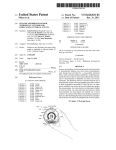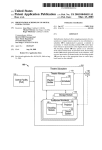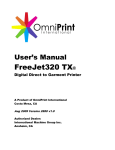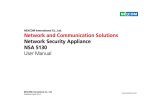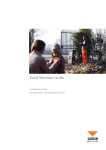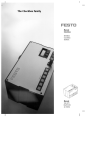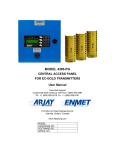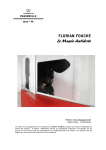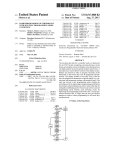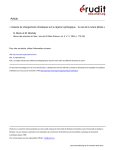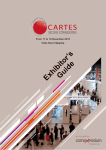Download (“312
Transcript
US 20130099011A1 (19) United States (12) Patent Application Publication (10) Pub. No.: US 2013/0099011 A1 MATSUOKA et al. (54) (43) Pub. Date: ENERGY EFFICIENCY PROMOTING Apr. 25, 2013 Publication Classi?cation SCHEDULE LEARNING ALGORITHMS FOR INTELLIGENT THERMOSTAT (51) (71) Applicant: NEST LABS, INC., Palo Alto, CA (US) Int- Cl G05D 23/19 (2006.01) (52) US, Cl, USPC ....................... .. 236/1 C; 236/46 C; 165/11.1 (72) Inventors: Yoky MATSUOKA, Palo Alto, CA View, CA (U S); Rangoli SHARAN, Sunnyvale, CA (Us); David SLOO, Menlo Park, CA (Us); Anthony Michael FADELL, P0110121 Valley, CA (Us) (73) Assignee? NEST LABS-1 INC‘: P2110 Alto: CA (Us) A user-friendly programmable thermostat is described that includes receiving an immediate-control input to change set point temperature, controlling temperature according to the set point temperature for a predetermined time interval, and then automatically resetting the set point temperature upon the ending of the predetermined time interval such that the user is urged to make further immediate-control inputs. A (21) Appl' NO‘: 13/656,200 schedule for the programmable thermostat is automatically _ (22) Flled: enerated based on the immediate-control in uts. Methods Oct‘ 19’ 2012 ire also described for receiving user input rlelating to the . . user’s Related U's' Apphcatlon Data (60) Provisional application No. 61/550,345, ?led on Oct. 21, 2011. automaticall eneratin a adopt an automatically generated schedule based on the received user input. ROTA TE RING m reference re ardin schedule), and determirgiing vgvhether or not go agutomaticilly (“312 Patent Application Publication Apr. 25, 2013 Sheet 1 0f 10 US 2013/0099011 A1 )r/“u ‘300 FIG. 1 4:. 2 G 2310 FIG. 2 Patent Application Publication ROTA TE RING Apr. 25, 2013 Sheet 2 0f 10 US 2013/0099011 A1 Patent Application Publication Apr. 25, 2013 Sheet 3 0f 10 US 2013/0099011 A1 FIG. 4B IN WARD CLICK Should Thermostat adjust the schedule automatically? FIG. 4C NO YES Should Thermostat /_ suggest changes to Thermostat Generates Program you each week? Through Learning; and Automatically Adjusts Schedule NO 31_6 YES NO/ Thermostat Thermostat Does Not Generate Program 424 Generates Program /_ Through Learning; and Suggests Changes Periodically 422 420 Patent Application Publication Apr. 25, 2013 Sheet 4 of 10 US 2013/0099011 A1 Is this a home or a business? busine’sf \[Zome Is this business open ls someone usually evenings? home at noon? l 512 J l Is this business open |s someone usuauy Saturdays? up after 11PM? IS there more than One thermostat in Is there more than one thermostat in this business? this home? l 1 Creating your basic Creating your basic schedule. . . schedule. . . FIG. 5B Patent Application Publication O Apr. 25, 2013 Sheet 5 0f 10 US 2013/0099011 Al _ 8° j 610 70° — J 60° — 6A 10A 2P 6P 1OP Tuesday 2A 6A Wednesday 80° — j 612 70° — l 600 — 6A 10A 2P 6P 1OP Tuesday 2A 6A Wednesday 80° — )- 614 70° — l 600 — 6A 10A 2P 6P Tuesday FIG. 6C 1OP 2A 6A Wednesday Patent Application Publication Apr. 25, 2013 Sheet 6 0f 10 US 2013/0099011 A1 ans w ‘Tm! Aneewscheduia ’ 1 Thermostat has ‘ has been created WWARU caicuiated a schedule that 10% would have saved last week cum‘ SEE NEW SCHEDULE DO NUT UPDATE m 31am SEE FI _ 7 I SCHEDULE i \QURRENT,» 346x \liCIK ‘ UPDATE SCHEUDLE DO NOT UPDATE FIG. 7E ‘ ‘ Patent Application Publication Apr. 25, 2013 Sheet 8 0f 10 US 2013/0099011 A1 Thermostat is learning your scheduie, piease adiust this thermostat frequen?y to make ourseif comfortahie ’ _ am FIG. 95 SET TEMP EXPIRES AT 6:35PM Piease set nighttime 7 temperature just prior 932_} FIG. 90 V i going tobed Patent Application Publication Apr. 25, 2013 Sheet 10 0f 10 US 2013/0099011 A1 [1110 80° 70° — 60° — 6A 10A 2P 6P 1OP 2A Tuesday 6A Wednesday 1 1 12 80° — r v I "' _ 1 70° — \ P ‘ \ /\ 1114 H 1.5hrs 1 H .5hrs 1.5hrs 1.5hrs 6Oo — 6A 10A 2P 6P 1OP 2A Tuesday 6A Wednesday 80° — I 1_ 70° - \ 1116 600 — 6A 10A 2P 6P Wenesday FIG. 11C 1OP 2A 6A Thursday Apr. 25, 2013 US 2013/0099011A1 ENERGY EFFICIENCY PROMOTING SCHEDULE LEARNING ALGORITHMS FOR INTELLIGENT THERMOSTAT [0001] This application claims the bene?t of Us. Prov. Application Ser. No. 61/550,345 ?led Oct. 21, 201 1, Which is incorporated by reference herein. FIELD [0002] This invention relates generally to the monitoring and control of HVAC systems and/or for other systems for controlling household utilities, and/or resources. More par ticularly, embodiments of this invention relate to systems, methods and related computer program products for facilitat ing user-friendly installation and/ or operation of a monitoring and control device such as a thermostat. BACKGROUND [0003] While substantial effort and attention continues toWard the development of neWer and more sustainable energy supplies, the conservation of energy by increased energy ef?ciency remains crucial to the World’s energy future. According to an October 2010 report from the Us. Department of Energy, heating and cooling account for 56% of the energy use in a typical Us. home, making it the largest energy expense for most homes. Along With improvements in the physical plant associated With home heating and cooling (e.g., improved insulation, higher ef?ciency furnaces), sub stantial increases in energy ef?ciency can be achieved by better control and regulation of home heating and cooling equipment. By activating heating, ventilation, and air condi tioning (HVAC) equipment for judiciously selected time intervals and carefully chosen operating levels, substantial energy can be saved While at the same time keeping the living space suitably comfortable for its occupants. [0004] Historically, hoWever, most knoWn HVAC thermo static control systems have tended to fall into one of tWo opposing categories, neither of Which is believed be optimal in most practical home environments. In a ?rst category are many simple, non-programmable home thermostats, each typically consisting of a single mechanical or electrical dial for setting a desired temperature and a single HEAT-FAN OFF-AC sWitch. While being easy to use for even the most unsophisticated occupant, any energy-saving control activity, such as adjusting the nighttime temperature or turning off all heating/ cooling just before departing the home, must be per formed manually by the user. As such, substantial energy saving opportunities are often missed for all but the most vigilant users. Moreover, more advanced energy-saving set tings are not provided, such as the ability to specify a custom temperature sWing, i.e., the difference betWeen the desired set temperature and actual current temperature (such as 1 to 3 degrees) required to trigger turn-on of the heating/cooling unit. [0005] In a second category, on the other hand, are many programmable thermostats, Which have become more preva lent in recent years in vieW of Energy Star (US) and TCO (Europe) standards, and Which have progressed considerably energy usage. Thus, even though the installed programmable thermostats in a large number of homes are technologically capable of operating the HVAC equipment With energy-sav ing pro?les, it is often the case that only the one-siZe-?ts-all manufacturer default pro?les are ever implemented in a large number of homes. Indeed, in an unfortunately large number of cases, a home user may permanently operate the unit in a “temporary” or “hold” mode, manually manipulating the dis played set temperature as if the unit Were a simple, non programmable thermostat. Thus, there is a need for a thermo stat having an improved user interface that is simple, intuitive and easy to use such that the typical user is able to access many of the features such as programming energy-saving pro?les. [0006] At a more general level, because of the fact that human beings must inevitably be involved, there is a tension that arises betWeen (i) the amount of energy-saving sophisti cation that canbe offered by an HVAC control system, and (ii) the extent to Which that energy-saving sophistication can be put to practical, everyday use in a large number of homes. Similar issues arise in the context of multi-unit apartment buildings, hotels, retail stores, o?ice buildings, industrial buildings, and more generally any living space or Work space having one or more HVAC systems. [0007] Some attempts have been made to make program ming of programmable thermostat more appealing to greater numbers ofusers. For example, U.S. Pat. Nos. 7,181,317 and 7,634,504 discuss methods for programming con?guration information for thermostats Wherein a series of intervieW questions are asked to a user. The user responses to the ques tions are stored and one or more schedule parameters can be modi?ed based on the user responses. It is believed, hoWever, that such approaches rely heavily or entirely on the user’s ansWers, and as a result Will be either Wasteful of energy and/or unnecessarily subject the occupants to uncomfortable temperatures When people make mistakes When enter their responses to the questions. [0008] Us. Pat. No. 7,784,704 discusses a self-program mable thermostat that initially appears to function as an ordi nary manual thermostat. The thermostat privately observes and learns a user’s manual temperature setting habits and eventually programs itself accordingly. The thermostat looks for patterns, such as three similar manual overrides on con secutive days. Manual set point changes override current programmed set point temperatures. It is believed, hoWever, that further improvement can be made in discussed method’ s ability to generate energy e?icient program schedules. SUMMARY [0009] According to some embodiments a thermostat is described that includes: a housing; a ring-shaped user-inter face component con?gured to track a rotational input motion from a user; a processing system disposed Within the housing and coupled to the ring-shaped user interface component, the processing system being con?gured to be in operative com munication With one or more temperature sensors for receiv ing ambient air temperature, the processing system further in the number of different settings for an HVAC system that being con?gured to be in operative communication With an HVAC system control the HVAC system based at least in part can be individually manipulated. Unfortunately, hoWever, on a comparison of the measured ambient temperature and a users are often intimidated by a diZZying array of sWitches and controls laid out in various con?gurations on the face of the thermostat or behind a panel door on the thermostat, and con?gured to identify a user’s desire to immediately control the setpoint temperature value based on the tracked rotational seldom adjust the manufacturer defaults to optimiZe their oWn input, the processing system still further being con?gured to setpoint temperature, the processing system further being Apr. 25, 2013 US 2013/0099011A1 automatically reset the setpoint temperature to a less energy consuming temperature upon an ending of a predetermined time interval and to generate, a schedule for the thermostat based at least in part on repeated identi?cations of the user’s desire to immediately control the setpoint temperature; and an electronic display coupled to the processing system and con?gured to display information representative of the iden ti?ed setpoint temperature value. [0010] According to some embodiments, the electronic dis play is disposed along a front face of the thermostat housing, displaying information representative of the ?rst and second identi?ed setpoint temperature values on the electronic dis play. [0013] According to some embodiments, the generated schedule is automatically adopted as an active schedule for the programmable thermostat. According to other embodi ments the user is noti?ed of the generated schedule; and user input is received as to Whether or not to adopt the generated schedule as an active schedule. the ring-shaped user interface component comprises a [0014] According to some embodiments a thermostat is described that includes: a disk-like housing including a cir mechanically rotatable ring that substantially surrounds the electronic display and is further con?gured to be inWardly cular front face; an electronic display centrally disposed on the front face; an annular ring member disposed around the pressable by the user along a direction of an axis of rotation of centrally disposed electronic display, said annular ring mem ber and said housing being mutually con?gured such that (i) the rotational input motion, and the mechanically rotatable ring and the housing are mutually con?gured such that said mechanically rotatable ring moves inWardly along said direc tion of said axis of rotation When inWardly pressed. Accord said annular ring member is rotatable around a front-to-back ing to some embodiments the thermostat housing is generally disk-like in shape With the front face thereof being circular, and Wherein the mechanically rotatable ring is generally coin axis of the thermostat, and (ii) said annular ring member is inWardly pressable along a direction of the front-to back axis; a processing system disposed Within the housing and coupled to the annular ring member; the processing system being con?gured and programmed to dynamically alter a setpoint cident With an outer lateral periphery of said disk-like shape. temperature value based on a user rotation of the annular ring [0011] member; the processing system being further con?gured to be According to some embodiments, the electronic dis play is further con?gured to display to a user a noti?cation relating to the generating of the schedule. According to some in operative communication With one or more temperature sensors for receiving an ambient air temperature, said pro embodiments in cases Where tWo or more immediate control ces sing system being still further con?gured to be in operative setpoint temperature changes are identi?ed Within a short time interval of less than 90 minutes, the generating of the communication With an HVAC system to control the HVAC system based at least in part on a comparison of the measured schedule is based on a latest of the tWo or more identi?cations. According to some embodiments, the automatic resetting of the setpoint temperature is to a base setpoint temperature of loWer than 68 degrees Fahrenheit at times When the HVAC system uses heating and to a base setpoint temperature of greater than 78 degrees Fahrenheit at time When the HVAC system uses cooling. According to some embodiments the generated schedule is automatically adopted as an active schedule for the programmable thermostat. [0012] According to some embodiments, a method is described for generating a schedule for a programmable ther mostat used for control of an HVAC system, the thermostat comprising a housing, a ring-shaped user interface compo nent, a processing system, and an electronic display. The described method includes: accessing an ambient air tem perature measured by one or more temperature sensors; ambient temperature and the setpoint temperature value; the processing system being still further con?gured to identify from the annular ring member user input relating to the user’ s preference regarding automatically generating a schedule and to determine therefrom Whether or not to automatically adopt an automatically generated schedule. According to some embodiments, an audio output device is includes that is coupled to said processing system, the thermostat being con ?gured to output synthesiZed audible ticks through said audio output device in correspondence With user rotation of said mechanically rotatable ring. [0015] As used herein the term “HVAC” includes systems providing both heating and cooling, heating only, cooling only, as Well as systems that provide other occupant comfort and/or conditioning functionality such as humidi?cation, dehumidi?cation and ventilation. detecting and tracking rotational movements of the ring [0016] shaped user-interface component to track at least one rota tional input motion of a user; identifying a ?rst setpoint tem perature value based on the tracked rotational input motion at to an HVAC system means a type of HVAC system that is As used herein the term “residential” When referring least in part on a comparison of the measured ambient air suitable to heat, cool and/or otherWise condition the interior of a building that is primarily used as a single family dWelling. An example of a cooling system that Would be considered residential Would have a cooling capacity of less than about 5 temperature and the ?rst setpoint temperature value for a tons of refrigeration (1 ton of refrigeration:l2,000 Btu/h). a ?rst point in time; controlling the HVAC system based at predetermined time interval; automatically resetting the ?rst setpoint temperature upon the ending of the predetermined time interval; identifying a second setpoint temperature value based on the tracked rotational input motion at a second point in time; controlling the HVAC system based at least in part on a comparison of the measured ambient air temperature and [0017] As used herein the term “light commercial” When referring to an HVAC system means a type of HVAC system that is suitable to heat, cool and/or otherWise condition the interior of a building that is primarily used for commercial purposes, but is of a siZe and construction that a residential the second setpoint temperature value for the predetermined time interval; automatically resetting the second set point temperature upon the ending of the predetermined time inter val; generating With the processing system, a schedule for the HVAC system is considered suitable. An example of a cooling programmable thermostat based at least in part on the ?rst and device or system for regulating parameters such as tempera second setpoints and the ?rst and second points in time; and ture and/ or humidity Within at least a part of an enclosure. The system that Would be considered residential Would have a cooling capacity of less than about 5 tons of refrigeration. [0018] As used herein the term “thermostat” means a Apr. 25, 2013 US 2013/0099011A1 term “thermostat” may include a control unit for a heating and/ or cooling system or a component part of a heater or air [0030] FIG. 8 shoWs an example of a Web-based user inter face for a thermostat that generates potential schedule adjust conditioner. [0019] As used herein the term “immediate-control input” ments and suggests them to a user for revieW and acceptance, to a setpoint temperature refers to input from a user to imme [0031] FIGS. 9A-D shoW aspects of a user interface for a thermostat adapted to learn and generate a schedule based on diately alter the currently active setpoint temperature. Thus an according to some embodiments; immediate-control input to a thermostat, also sometimes immediate-control inputs made by the occupants, according referred to as a “real time” setpoint entry, indicates a user’s to some embodiments; desire to make an immediate change in the currently setpoint temperature in an HVAC system being controlled by the [0032] FIGS. 10A-D shoW examples of automatically gen erating a schedule using a “?at line” starting point and leam ing from immediate-control inputs, according to some thermostat. Immediate-control inputs can be made by users either by directly manually interfacing With the thermostat, or by using a remote user interface such as by using a mobile phone, tablet computer and/ or Web interface on a computer. [0020] As used herein the term “schedule-change input” refers to input from a user or other source to modify a pro embodiments; and [0033] FIGS. 11A-C shoW examples of automatically gen erating a schedule using a “?at line” starting point and leam ing from immediate-control inputs, according to some embodiments. grammed schedule for setpoint changes. Thus a user’s sched ule-change input to a thermostat, also sometime referred to as a “non-real-time” setpoint entry or change, indicates the user’s desire to make changes to one or more of the thermo stat’s programmed setpoints. In contrast to an immediate control input, Where the user desires to immediately effect the currently active setpoint, a schedule-change input indicates a user’s desire to make a change (for example temperature or time) to a setpoint that Will become active in the future. As in the case of immediate-control inputs, users can make sched ule-change inputs either by directly manually interfacing With the thermostat, or by using a remote user interface such as by using a mobile phone, tablet computer and/or Web interface on a computer. [0021] It Will be appreciated that these systems and meth ods are novel, as are applications thereof and many of the components, systems, methods and algorithms employed and included therein. It should be appreciated that embodiments of the presently described inventive body of Work can be implemented in numerous Ways, including as processes, apparatuses, systems, devices, methods, computer readable media, computational algorithms, embedded or distributed softWare and/ or as a combination thereof. Several illustrative embodiments are described beloW. BRIEF DESCRIPTION OF THE DRAWINGS [0022] The inventive body of Work Will be readily under stood by referring to the folloWing detailed description in conjunction With the accompanying draWings, in Which: [0023] FIG. 1 is a diagram of an enclosure in Which envi ronmental conditions are controlled, according to some embodiments; [0024] FIG. 2 is a diagram of an HVAC system, according to some embodiments; [0025] FIGS. 3A-B illustrate a thermostat having a user DETAILED DESCRIPTION [0034] A detailed description of the inventive body of Work is provided beloW. While several embodiments are described, it should be understood that the inventive body of Work is not limited to any one embodiment, but instead encompasses numerous alternatives, modi?cations, and equivalents. In addition, While numerous speci?c details are set forth in the folloWing description in order to provide a thorough under standing of the inventive body of Work, some embodiments can be practiced Without some or all of these details. More over, for the purpose of clarity, certain technical material that is knoWn in the related art has not been described in detail in order to avoid unnecessarily obscuring the inventive body of Work. [0035] FIG. 1 is a diagram of an enclosure in Which envi ronmental conditions are controlled, according to some embodiments. Enclosure 100, in this example is a single family dWelling. According to other embodiments, the enclo sure can be, for example, a duplex, an apartment Within an apartment building, a light commercial structure such as an o?ice or retail store, or a structure or enclosure that is a combination of the above. Thermostat 110 controls HVAC system 120 as Will be described in further detail beloW. According to some embodiments, the HVAC system 120 is has a cooling capacity less than about 5 tons. According to some embodiments, a remote device 112 Wirelessly commu nicates With the thermostat 110 and can be used to display information to a user and to receive user input from the remote location of the device 112. Although many of the embodi ments are described herein as being carried out by a thermo stat such as thermostat 110, according to some embodiments, the same or similar techniques are employed using a remote device such as device 112. friendly interface, according to some embodiments; [0036] FIG. 2 is a diagram of an HVAC system, according to some embodiments. HVAC system 120 provides heating, [0026] cooling, ventilation, and/or air handling for the enclosure, FIGS. 4A-C shoW aspects of a user interface for a thermostat having learning and self-programming capabili ties, according to some embodiments; [0027] FIGS. 5A-B shoW aspects of a user interface for generating a program, according to some embodiments; [0028] FIGS. 6A-C shoW examples of basic schedules gen erated based on ansWers to basic questions, such as those such as a single-family home 100 depicted in FIG. 1. The system 120 depicts a forced air type heating system, although according to other embodiments, other types of systems could be used. In heating, heating coils or elements 242 Within air handler 240 provide a source of heat using electricity or gas via line 236. Cool air is draWn from the enclosure via return shoWn in FIG. 5B, according to some embodiments; air duct 246 through ?lter 270, using fan 238 and is heated [0029] FIGS. 7A-E shoW aspects of a user interface for a heating coils or elements 242. The heated air ?oWs back into thermostat that generates potential schedule adjustments and the enclosure at one or more locations via supply air duct suggests them to a user for revieW and acceptance, according system 252 and supply air grills such as grill 250. In cooling, to some embodiments; an outside compressor 230 passes gas such a Freon through a Apr. 25, 2013 US 2013/0099011A1 set of heat exchanger coils to cool the gas. The gas then goes to the cooling coils 234 in the air handlers 240 Where it expands, cools and cools the air being circulated through the enclosure via fan 238. According to some embodiments a humidi?er 254 is also provided. Although not shoWn in FIG. 2, according to some embodiments the HVAC system has other knoWn functionality such as venting air to and from the outside, and one or more dampers to control air?oW Within the duct systems. The system is controlled by algorithms imple mented via control electronics 212 that communicate With a thermostat 110. Thermostat 110 controls the HVAC system 120 through a number of control circuits. Thermostat 110 also includes a processing system 260 such as a microprocessor that is adapted and programmed to controlling the HVAC system and to carry out the techniques described in detail herein. [0037] FIGS. 3A-B illustrate a thermostat having a user friendly interface, according to some embodiments. Unlike so many prior art thermostats, thermostat 300 preferably has a sleek, simple, uncluttered and elegant design that does not detract from home decoration, and indeed can serve as a visually pleasing centerpiece for the immediate location in Which it is installed. Moreover user interaction With thermo stat 300 is facilitated and greatly enhanced over conventional designs by the design of thermostat 300. The thermostat 300 porated by reference herein. According to some embodi ments, occupancy information is used in generating an effec tive and e?icient scheduled program. [0039] According to some embodiments, for the combined purposes of inspiring user con?dence and further promoting visual and functional elegance, the thermostat 300 is con trolled by only tWo types of user input, the ?rst being a rotation of the outer ring 312 as shoWn in FIG. 3A (referenced hereafter as a “rotate ring” input), and the second being an inWard push on the upper cap 308 (FIG. 3B) until an audible and/or tactile “click” occurs (referenced hereafter as an “inWard click” input). For further details of suitable user interfaces and related designs Which are employed, according to some embodiments, see co-pending patent application U.S. Ser. No. 13/033,573 and Us. Ser. No. 29/386,021, both ?led Feb. 23, 201 1, and are incorporated herein by reference. The subject matter of the instant patent speci?cation is further related to that of the folloWing commonly assigned applica tions, each of Which is incorporated by reference herein: U.S. Ser. No. 13/279,151 ?led Oct. 21, 2011; Us. Prov. Ser. No. 61/627,996 ?led Oct. 21, 2011; Us. Prov. Ser. No. 61/550, 343 ?led Oct. 21, 2011; and Us. Prov. Ser. No. 61/550,346 ?led Oct. 21, 2011. [0040] According to some embodiments, the thermostat 300 includes a processing system 360, display driver 364 and includes control circuitry and is electrically connected to an HVAC system, such as is shoWn With thermostat 110 in FIGS. 1 and 2. Thermostat 300 is Wall mounted and has circular in shape and has an outer rotatable ring 312 for receiving user input. Thermostat 300 has a large frontal display area 314. According to some embodiments, thermostat 300 is approxi mately 80 mm in diameter. The outer rotating ring 312 alloWs a Wireless communications system 366. The processing sys tem 360 is adapted to cause the display driver 364 and display the user to make adjustments, such as selecting a neW target thermodynamic modeling, see U.S. patent Ser. No. 12/881, 463 ?led, Which is incorporated by reference herein. Accord temperature. For example, by rotating the outer ring 312 clockWise, the target temperature can be increased, and by rotating the outer ring 312 counter-clockWise, the target tem area 316 to display information to the user, and to receiver user input via the rotating ring 312. The processing system 360, according to some embodiments, is capable of maintain ing and updating a thermodynamic model for the enclosure in Which the HVAC system is installed. For further detail on the ing to some embodiments, the Wireless communications sys tem 3 66 is used to communicate With devices such as personal computers and/or other thermostats or HVAC system compo perature can be decreased. Within the outer ring 312 is a clear cover 314 Which according to some embodiments is polycar nents. bonate. Also Within the rotating ring 312 is a metallic portion 324, preferably having a number of WindoWs as shoWn. thermostat having learning and self-programming capabili According to some embodiments, the surface of cover 314 ties, according to some embodiments. FIG. 4A shoWs an and metallic portion 324 form a curved spherical shape gently arcing outWard that matches a portion of the surface of rotat ing ring 312. [0038] According to some embodiments, the cover 314 is painted or smoked around the outer portion, but leaving a central display 316 clear so as to facilitate display of infor mation to users. According to some embodiments, the curved [0041] FIGS. 4A-C shoW aspects of a user interface for a example of a display 316 of thermostat 300 described With respect to FIGS. 3A-B. The display 316 indicates that the user is making settings With respect to the ther'mostat’s learning functionality. The colored disk 410 indicates that the learning setting that Will be entered, if selected using an inWard click, tion being displayed in display 316 to users. According to relates to Whether the user Will be asked about changes made to the program schedule. FIG. 4B shoWs the display 316 folloWing a user selection using an inWard click. In FIG. 4B, the user is asked to if the thermostat should adjust the sched some embodiments central display 316 is a dot-matrix layout ule automatically. Using the rotating ring the and inWard click (individually addressable) such that arbitrary shapes can be generated, rather than being a segmented layout. According the user selects “yes” or “no.” If the user selects “yes,” then in step 420 the thermostat automatically generates one or more programs, such as described more fully herein. If the user cover 314 acts as a lens Which tends to magnify the informa to some embodiments, a combination of dot-matrix layout and segmented layout is employed. According to some embodiments, central display 316 is a backlit color liquid crystal display (LCD). An example of information is shoWn in FIG. 3A, Which are central numerals 320. According to some embodiments, metallic portion 324 has number of openings so as to alloW the use of a passive infrared proximity sensor selects “no,” the thermostat, according to some embodiments, the thermostat nevertheless records some or all of the user’s adjustments in set temperature and generates suggested schedule changes according to certain criteria (for example, energy or cost savings to the user). According to some embodiments, if the user ansWers “no” to the question about 330 mounted beneath the portion 324. The proximity sensor automatically adjusting the schedule, the thermostat asks the as Well as other techniques can be use used to detect and/or user, as shoWn in display 316 of FIG. 4C, if the thermostat should suggest changes to the user each Week. If the user ansWers “yes,” then in step 422, the thermostat generates a predict occupancy, as is described further in co-pending patent application U.S. Ser. No. 12/881,430, Which is incor Apr. 25, 2013 US 2013/0099011Al schedule based on learning from the user’s immediate-con [0045] trol inputs in combination With other information, and peri odically suggests changes to the user according to certain criteria (for example, energy saving or costs savings). If the thermostat that generates potential schedule adjustments and suggests them to a user for revieW and acceptance, according to some embodiments. FIG. 7A shoW the thermostat 300 With user ansWers “no,” then in step 424 the thermostat does not display 316. A message bubble 710 is overlaid on the display generate any program and instead alWays folloWs the pro 316 to obtain the user’ s attention. According to some embodi ments, one or more proximity sensors (not shoWn) are used to gram set by the user. FIGS. 7A-E shoW aspects of a user interface for a detect When an occupant is approaching the thermostat 300. [0042] FIGS. 5A-B shoW aspects of a user interface for generating a program, according to some embodiments. In Upon sensing an approaching occupant, the message bubble FIG. 5A, the user can select entering set-up questions relating to the schedule settings as indicated by the colored disk 510, using an inWard click input While the thermostat is displays user Wishes further information an inWard click input leads to the screen as shoWn in display 316. FIG. 5B is a How chart shoWing questions that can be asked of the user in order to generate a basic schedule, according to some embodiments. As can be seen from the How chart 512 of FIG. 5B, the user is initially asked if the thermostat is installed in a home or business. Then some basic questions are asked to generate a basic schedule, such as Whether the home is usually occupied at noon, is someone usually up after 11 pm, and Whether or not there is more than one thermostat in the home. Similar questions are asked is the thermostat is installed in a business. According to some embodiments, a basic schedule is gener ated based on the ansWers to the questions in FIG. 5B. 710 is displayed in order to obtain the user’s attention. If the the display 316 shoWn in FIG. 7B. In FIG. 7B, the thermostat indicates to the user that a neW schedule has been calculated that is estimated Would have saved about 10% of energy costs in the past Week. The user has the choice to vieW the neW schedule or reject it. If the user indicates a desire to see the neW schedule, then an animation is displayed Which alter nates betWeen FIG. 7C shoWing the current schedule, and FIG. 7D shoWing the proposed neW schedule. In FIG. 7C, the current set point temperature 722 is shoWn and the applicable erated based on ansWers to basic questions, such as those time 724 is shoWn beloW. In FIG. 7D, the neW set point temperature 722 is shoWn and the neW time 724 is shoWn beloW. If there are further changes to the schedule then those can be accessed by rotating the ring to the right or left. When the user is ?nished revieWing the neW schedule, the user, in FIG. 7E is given the choice to updated the schedule or not. [0046] FIG. 8 shoWs an example of a Web-based user inter shoWn in FIG. 5B, according to some embodiments. In FIG. 6A, curve 610 shoWs a basic schedule for setpoints from 6 am Tuesday to 6 am Wednesday, Which corresponds to a home that the user indicated is occupied during noon and the user ments and suggests them to a user for revieW and acceptance, according to some embodiments. A computer monitor 810 is used to display to a user of the thermostat suggested schedule indicated that someone is not usually up at 11 pm. As can be changes. The user can use a pointing device such as mouse seen, the setpoint temperature changes at 7 am from 62 degrees to 72 degrees and then stays at 72 degrees until 10 pm When it changes back to 62 degrees. In FIG. 6B, curve 612 820 to move a pointer 822 to provide input. In the WindoW 812, the user is asked in bubble 814 Whether the displayed schedule change should be adopted. According to some embodiments, further information, such as the estimated amount of energy savings associated With the proposed change can be displayed to aid the user in making a decision. The current schedule is shoWn in solid circles and the pro posed changes are shoWn in dotted circles. For example, the set back time to 62 degrees in the morning is suggested to be changed from 9 am (shoWn by solid circle 830) to about 9:30 am (shoWn by dotted circle 832), and the evening set back to [0043] FIGS. 6A-B shoW examples of basic schedules gen shoWs a basic schedule that corresponds to a home that the user indicated is not occupied during noon and that someone is not usually up at 11 pm. As can be seen, the set point temperature changes at 7 am from 62 degrees to 72 degrees. Then, at 9 am, the temperature is set back to 62 degrees until 5 pm, When the set point is changed to 72 degrees. The set back from 9 am to 5 pm is due to the user’s indication that no one is usually home at noon. In FIG. 6C, curve 614 corre sponds to a user’s indication that no one is usually home at noon, and some one is usually up at 11 pm. In this case the evening set back time is set to midnight.As can be seen abasic face for a thermostat that generates potential schedule adjust 62 degrees is suggested to be changed from midnight (shoWn by the solid circle 840) to about 10:15 pm (shoWn by the dotted circle 842).According to some embodiments, a “snap” schedule is limited by the simple questions that it is based button or similar can be provided to the user for the user to upon, and as a results the occupants may either be uncom fortable, or energy use and costs may be higher than neces easily adopt all the suggested schedule changes. According to sary. For example, the occupants may get up before 7 am, or shoWn in FIG. 8 to make their oWn adjustments and/or accept they may be perfectly comfortable at 68 degrees instead of 72 degrees. According to some embodiments, further questions or reject particular suggested changes by clicking and drag are asked of the user, such as Whether someone is usually up at 6:30 am, or if the occupants are comfortable at 68 degrees. user interface experience, as Well as introduces potential temperature value Within one or more of the circles. Accord ing to some embodiments, the interface screen such as shoWn in FIG. 8 can be displayed at the request of the user, or it can be shoWn at the request of a central server, such as is common errors based on Wrong ansWers and/or misunderstood ques in push technology. According to some embodiments, the tions. decision on When to “push” a noti?cation of a suggested schedule change can be based at least in part on an estimation HoWever, each additional question detracts from the simple [0044] According to some embodiments, after generating some embodiments, the user can also use the interface as ging the circles along the time line, and/or by changing the the basic schedule based on a feW simple questions such as of energy and/or cost savings being above a predetermined shoWn in FIGS. 6A-C, the thermostat learns from the user’s immediate-control inputs and periodically suggests, or auto threshold or percentage value. matically implements schedule changes that meet certain cri immediate-control inputs can be useful in generating a sched ule and/or adjustments to an existing scheduled program, it teria. [0047] While simply observing and recording a user’s Apr. 25, 2013 US 2013/0099011Al has been found, unexpectedly, that the thermostat can more effectively learn and generate a scheduled program that makes the user more comfortable While saving energy and [0050] It has been found, quite unexpectedly, that in many circumstances the thermostat can more quickly and effec tively generate a schedule that balances user comfort With cost When the user is periodically urged to input settings to cost and energy savings, When the starting point for gathering maintain or improve the user’ s comfort. Bothering the user by periodically urging manual input may at ?rst appear to run counter to a user-friendly experience, but it has been found the user’s input is a “?at-line” or constant temperature that may be quite uncomfortable to many users, but saves signi? that this technique very quickly alloWs the thermostat to gen cant energy. For example the starting point or initial setting for the thermostat in geographic locations and times of the erate a schedule that improves user comfort While saving costs, and thus turns out to be very user-friendly overall. year When heating is predominantly called for (rather than [0048] According to some preferred embodiments, there fore, a user’s set point change automatically expires after a predetermined amount of time. By automatically re-setting or setting back a user’s set point adjustment after a predeter geographic locations and times of year When cooling is pre cooling) is a constant loW temperature such as 62 degrees F. In dominantly called for the starting “?at line” is, for example, 85 degrees F. This “?at-line” starting point, When combined mined amount of time, the user is urged to repeatedly make set point changes to maintain or improve comfort. As a result, With automatic re-setting or expiring of the user’ s immediate control inputs after a predetermined amount of time has been found to be more effective in many situations than starting the thermostat is able to learn and generate a much more With a basic schedule based on a number of basic questions, effective schedule in terms of both comfort for the occupants as Well as energy e?iciency and cost savings. In this Way, the thermostat can learn both the set point temperature, the occu pants regard as providing comfort, as Well as the times of the day When the user bene?ts from set point changes, as Well as such as shoWing in FIG. 5B. times of the day, such as during periods When the conditioned Zone is unoccupied, When the set point temperature can be set back in order to save cost and energy While having a little or no impact on occupant comfort. [0049] FIGS. 9A-D shoW aspects of a user interface for a thermostat adapted to learn and generate a schedule based on [0051] FIGS. 10A-D shoW examples of automatically gen erating a schedule using a “?at line” starting point and leam ing from immediate-control inputs, according to some embodiments. FIG. 10A shoWs the starting point schedule 1010 Which is a “?at line” of 62 degrees throughout the day. According to some embodiments, the starting point tempera ture is selected using a number of criteria. Firstly, a determi nation should be made as to Whether heating or cooling is likely to be called for. In cases Where the HVAC system being controlled by the thermostat has both heating and cooling immediate-control changes made by the occupants, accord functionality, then the determination of Which to use can in ing to some embodiments. In FIG. 9A, the thermostat 300 uses display 316 to inform the user using message bubble 920 that the thermostat is in the process of learning in order to generate a schedule that is suitable for the occupants. The user is asked to adjust the thermostat frequently to make the user comfortable. As shoWn in FIG. 9A, the current set point temperature is set to 62 degrees F. as indicated by the set point tick 910. In FIG. 9B, a user adjusts the set point temperature, or makes an immediate-control input, to improve comfort by many or most cases be made using a combination of geo rotating the outer ring 312. The current temperature is 62 degrees F., as indicated by the current temperature tick 912, and the set point has been adjusted to 75, as indicated by the set point tick 910 and by the large central numerals. Addi tionally, the user is reminded that the thermostat is learning by a ?ashing “leaming” message 922. FIG. 9C shoWs display 316 folloWing an immediate-control input such as described With respect to FIG. 9B. According to some embodiments, as described above, immediate-control input expires after a pre graphic location (eg using postal or ZIP code) Which is knoWn or gathered from basic set up information, and the time of year (from the date). In some locations and times of the year, hoWever, it may be unclear Whether the user Will Want to predominantly use heating or cooling. According to some embodiments, the user’ s ?rst immediate-control input is used in such cases. For example, if the user makes an immediate control input to set the temperature greater than the ambient temperature, then it is assumed heating is Wanted. According to other embodiments, the user is asked using a message bubble or the like, in such cases. Secondly, a determination should be made as to What temperature should be used as the base “?at line.”According to some embodiments, a tempera ture is selected at Which many or most occupants Would consider at least someWhat uncomfortable such that an occu pant Would likely Wish to make an immediate-control input to improve comfort. The base temperature should not be too determined amount of time so as to enhance the ability of the uncomfortable, hoWever, since doing so Would unnecessarily thermostat 300 to learn and generate effective and e?icient schedules. The current temperature of 75 degrees F. is dis subject to occupants to discomfort. It has been found that When heating is called for, a base value of betWeen 60 and 64 played in the large central numerals. The set point tempera degrees is suitable for many geographic locations. ture, Which Was manually entered as an immediate-control [0052] According to some embodiments, the user is noti ?ed that the thermostat is trying to learn and generate a schedule, such as using a message bubble as shoWn in FIG. 9A. In FIG. 10B, the curve 1012 shoWs the user’s immediate input, is shoWn by the set point tick 910. The user is informed that the immediate-control input Will automatically expire at 6:35 pm in message 930. According to an alternate embodi ment, a the message 930 displays a countdoWn timer shoWing hoW many minutes remain until the user’ s immediate-control input expires. FIG. 9D shoWs a message bubble 932 that informs the user that a comfortable nighttime temperature should be manually entered just prior to going to bed. Accord ing to some embodiments, the message such as shoWn in FIG. 9D is automatically displayed after a certain time of day (such as 9 pm) When one or more proximity sensors detect When an occupant is approaching the thermostat 300. control inputs throughout the day and curve 1014 shoWs the indoor temperature sensed by the thermostat. A time 1020, about 7:15 am, the user makes an immediate-control input to change the set point temperature from 62 degrees to 72 degrees. According to some embodiments, the set point tem perature automatically is set to expire after a predetermined amount of time, Which in this example is tWo hours. Thus, at about 9:15 am, the set point is automatically set back to the base line value of 62 degrees. In this example the user has US 2013/0099011A1 Apr. 25, 2013 gone out of the house for the day, and so does not make any immediate-control inputs until the user returns home. At time 1022, about 5:20 pm, the user makes an immediate-control for (eg based on the geographic location and time of year, as described above). In FIG. 11B, curve 1112 shoWs the set point input to adjust the set point to 68 degrees. In this example the predetermined expiry period is tWo hours, so the set point is and curve 1114 shoWs the ambient indoor temperature as automatically set back to 62 degrees at about 7:20 pm. According to some embodiments, the user is informed of the expiry time using a message such as shoWn in FIG. 9C. Still referring to FIG. 10B, the user at time 1024, about 7:45 pm, the user makes an immediate-control input to adjust the set expiry time (or reset time) is 1.5 hours. At 7:10 am, the user makes an immediate-control input to 70 degrees. The set point is maintained for 1.5 hours, and at 8:40 am, the set point is automatically set back to 80 degrees. At 5: 11 pm the user point temperature to 69 degrees. The set point is automati cally set back to 62 degrees after tWo hours, at about 9:45 pm. In this example, the occupants have gone to bed before or not long after 9:45, so no further immediate-control inputs are settings from immediate-control inputs and automatic resets, sensed by the thermostat. In this example, the predetermined returns home and makes an immediate-control input to 73 degrees Which is maintained for 1.5 hours. At 6:41 pm this set point “expires” and set point is automatically set back to the base value of 80 degrees. At 7:16 pm the user again makes an made that day. immediate-control input, but this time to 72 degrees. At 8:46 pm this set point “expires” and the set point is automatically [0053] FIG. 10C shoWs a schedule curve 1016 that has been generated based on the user’s immediate-control inputs on again makes an immediate-control input to 72 degrees. At the previous day (as shoWn in FIG. 10B). The temperature is set in the morning at 7:15 am to 72 degrees until it is set back at 9:15 am to 62 degrees. At 5:20, the temperature is set to 69 degrees until it is set back at 9:45 pm to 62 degrees. Note that both the times of day and set point temperatures have been used in generating the schedule shoWn in FIG. 10C. Addi tionally, according to some embodiments, the short gap from 7:20, When the temperature Was automatically set back, and 7:45 When the user made an immediate-control input, is ignored. Also, the setpoint temperatures in the evening of 68 and 69 degrees Where not identical and either an average or the later set temperature Was used, in this case 69 degrees. [0054] According to some embodiments, the shortest time for a scheduled set point segment is set to 60 minutes. If tWo immediate-control inputs occur Within the 60 minutes of each other, the later Will generally be use and the earlier setting or settings Will be ignored. FIG. 10D illustrates some example scenarios, With curve 1030 shoWing the set point temperature of the thermostat as manually and automatically adjusted, and curve 1032 shoWs the current indoor temperature sensed by the thermostat. At time 1040, about 7:15 am, the an immedi ate-control input is made by the user change the set point to 77 degrees, but about 30 minutes later at time 1044, about 7:45 am, the user makes an immediate-control input changing the set point to 72 degrees. Since the tWo immediate-control inputs occurred Within a short time (in this case 30 minutes), the ?rst setting is assumed to be erroneous and is ignored for set back to the base value of 80 degrees. At 9:44 pm, the user 1 1:14 pm this set point expires, but the user makes no further immediate-control inputs. FIG. 11C shoWs an example of a schedule 1116 that is automatically generated based on the user input shoWn in curve 1112 of FIG. 11B. In schedule 1116, a set point of 70 degrees is made betWeen 7:10 am and 8:40 am. During the day, the house is assumed to be unoccu pied (since no immediate-control inputs Were made on the learning day shoWn in FIG. 11B), and the temperature is set back to 80 degrees. At 5:11 pm the temperature is set to 73 degrees and then from 7:16 pm to 11:14 pm the temperature is set to 72 degrees. [0056] Note that in the examples shoWn in FIGS. 10A-D the predetermined expiry time is 2 hours and in the examples shoWn FIGS. 11A-C the predetermined expiry time is 1.5 hours. It has been found, if the period of time after Which the user’s immediate-control input is shorter than 30 minutes, this generally cause excessive annoyance to the occupants. On the other hand, if the time is greater than 6 hours, the resulting generated schedule is likely to be Wasteful of cost and energy since periods of non-occupancy and/or sleeping are not accurately captured. According to some embodiments the time period is greater than 1 hour and less than or equal to 5 hours. According to some preferred embodiments, time periods of betWeen 1.5 hours and 3 hours have been found to strike a very good compromise betWeen annoyance to the occupants and energy ef?ciency of the resulting schedule. [0057] According to some embodiments, the learning pro purposed of the automatically generated schedule. Similarly, cess described herein With respect to FIGS. 9-11 can be a time 1046 an immediate-control input is made and about 20 minutes later an immediate-control input resets the tempera ture to the base line level. Since the setting Was effectively cancelled, it is assumed to be erroneous and ignored for carried out separately for Weekdays versus Weekend days. For example, the “?at-line” learning method described can be purposed of the automatically generated schedule. If, on the other hand, the immediate-control input Was not reset for 45 minutes or more, then the immediate-control input is not ignored, according to some embodiments, and segment Would be created in the generated schedule for 60 minutes duration. Note that folloWing the described rules, the imme diate-control inputs as shoWn in curve 1030 Would lead to an automatically generated schedule as shoWn by curve 1016 in carried out on a Weekday as described Which generates a suitable schedule for Weekdays. Then, on the ?rst Weekend day, a neW “?at-line” learning process is started, since it is assumed that for many people the Weekday and Weekend day schedules are vastly different. [0058] According to some embodiments, the described learning processes continue even after a schedule is activated. For example, folloWing a learning process, a schedule such as shoWn in FIGS. 10C and/ or 11C are generated and activated. FIG. 10C. The thermostat continues to learn by Watching and recording immediate-control inputs. After repeated immediate-control [0055] FIGS. 11A-C shoW examples of automatically gen erating a schedule using a “?at line” starting point and leam ing from immediate-control inputs, according to some change are automatically implemented or suggested to the user. According to some embodiments, if a user makes similar embodiments. FIG. 11A shoWs set point curve 1110 that is an immediate-control inputs three days in a roW (Where “simi example of a “?at line” base value of 80 degrees that is suitable When cooling is believed to be predominantly called made With 60 minutes of each other), a schedule-change is inputs are made, the decision is made as Whether and schedule lar” is de?ned, for example, as adjustments Within 5 degrees Apr. 25, 2013 US 2013/0099011A1 automatically inputted (and the user noti?ed), or the sched ule-change input is suggested to the user. According to some embodiments, estimated energy and/or cost savings is also used as a criterion for implementing or suggesting schedule change inputs. [0059] According to some embodiments, the continued learning process as described above is used for adjusting, or repeated identi?cations of the user’s desire to immedi ately control the setpoint temperature; and an electronic display coupled to the processing system and con?gured to display information representative of the identi?ed setpoint temperature value. 2. A thermostat according to claim 1 Wherein: said electronic display is disposed along a front face of the suggesting improvements to a basic schedule generated from thermostat housing; a basic set of questions as shoWn in and described With respect said ring-shaped user interface component comprises a to FIGS. 5-6. HoWever, it has been found that in many appli cations, starting With a “?at-line” Works to more effectively learn the user’s preferences. According to some embodi ments, the continued learning process is also carried out in cases Where the user has indicated that they Wish to manually the electronic display and is further con?gured to be inWardly pressable by the user along a direction of an axis of rotation of the rotational input motion; and said mechanically rotatable ring and said housing are enter their oWn scheduled program. In such cases, for mechanically rotatable ring that substantially surrounds mutually con?gured such that said mechanically rotat able ring moves inWardly along said direction of said axis of rotation When inWardly pressed. example, changes to the schedule can be suggested according to the potential for energy and/ or cost savings. [0060] According to some embodiments, occupancy data can also be incorporated in the process of automatically gen erating a schedule for adoption and/ or suggestion to the user. It has been found that occupancy data is particularly useful in cases using automatic set back after a time period, Where the time is relatively longisuch as three or more hours. In cases Where the thermostat is installed in a dWelling that is rela tively large, then local-proximity-based occupancy sensing may not be accurate for relatively short periods of time because occupants may simply be in a different part of the dWelling during that time period. HoWever, if there is no occupancy sensed close to the thermostat for greater than tWo hours, then it is increasingly likely that the dWelling is in fact not occupied. [0061] Although the foregoing has been described in some detail for purposes of clarity, it Will be apparent that certain changes and modi?cations may be made Without departing from the principles thereof. It should be noted that there are many alternative Ways of implementing both the processes and apparatuses described herein. Accordingly, the present embodiments are to be considered as illustrative and not restrictive, and the inventive body of Work is not to be limited to the details given herein, Which may be modi?ed Within the scope and equivalents of the appended claims. What is claimed is: 1. A thermostat comprising: a housing; a ring-shaped user-interface component con?gured to track a rotational input motion from a user; a processing system disposed Within the housing and coupled to the ring-shaped user interface component, the processing system being con?gured to be in opera tive communication With one or more temperature sen sors for receiving ambient air temperature, the process ing system further being con?gured to be in operative 3. A thermostat according to claim 2 Wherein said thermo stat housing is generally disk-like in shape With said front face thereof being circular, and Wherein said mechanically rotat able ring is generally coincident With an outer lateral periph ery of said disk-like shape. 4. A thermostat according to claim 1 Wherein said thermo stat is con?gured such that said rotational input motions and said inWard pressings of the ring-shaped user-interface com ponent represent the sole physical user inputs to said thermo stat. 5. A thermostat according to claim 1 Wherein the predeter mined time interval is at least about 1 hour and less than about 4 hours. 6. A thermostat according to claim 5 Wherein the predeter mined time interval is at least 1.5 hours and less than about 3 hours. 7. A thermostat according to claim 1 Wherein the electronic display is further con?gured to display to a user a noti?cation relating to the generating of the schedule. 8. A thermostat according to claim 1 Wherein the process ing system is still further con?gured such that in cases Where tWo or more immediate control setpoint temperature changes are identi?ed Within a short time interval of less than 90 minutes, the generating of the schedule is based on a latest of the tWo or more identi?cations. 9. A thermostat according to claim 1 Wherein the process ing system is still further con?gured such that the automatic resetting of the setpoint temperature is to a base setpoint temperature of loWer than 68 degrees Fahrenheit at times When the HVAC system uses heating and to a base setpoint temperature of greater than 78 degrees Fahrenheit at time When the HVAC system uses cooling. 10. A thermostat according to claim 1 Wherein the process ing system is still further con?gured such that the generated schedule is automatically adopted as an active schedule for the programmable thermostat. communication With an HVAC system control the HVAC system based at least in part on a comparison of the measured ambient temperature and a setpoint tem 11. A method for generating a schedule for a program mable thermostat used for control of an HVAC system, the perature, the processing system further being con?gured thermostat comprising a housing, a ring-shapeduser interface component, a processing system, and an electronic display, to identify a user’s desire to immediately control the setpoint temperature value based on the tracked rota the method comprising: tional input, the processing system still further being con?gured to automatically reset the setpoint tempera accessing an ambient air temperature measured by one or ture to a less energy-consuming temperature upon an detecting and tracking rotational movements of the ring ending of a predetermined time interval and to generate a schedule for the thermostat based at least in part on more temperature sensors; shaped user-interface component to track at least one rotational input motion of a user; Apr. 25, 2013 US 2013/0099011A1 identifying a ?rst setpoint temperature value based on the tracked rotational input motion at a ?rst point in time; controlling the HVAC system based at least in part on a comparison of the measured ambient air temperature and the ?rst setpoint temperature value for a predeter mined time interval; automatically resetting the ?rst setpoint temperature upon the ending of the predetermined time interval; identifying a second setpoint temperature value based on the tracked rotational input motion at a second point in time; controlling the HVAC system based at least in part on a comparison of the measured ambient air temperature and the second setpoint temperature value for the pre determined time interval; automatically resetting the second set point temperature upon the ending of the predetermined time interval; generating With the processing system, a schedule for the programmable thermostat based at least in part on the ?rst and second setpoints and the ?rst and second points in time; and displaying information representative of the ?rst and sec ond identi?ed setpoint temperature values on the elec tronic display. 12. A method according to claim 11 Wherein the predeter mined time interval is at least about 30 minutes and less than about 6 hours. 13. A method according to claim 12 Wherein the predeter mined time interval is about 2 hours. 14. A method according to claim 11 Wherein the resetting of the ?rst and second set points resets the set point tempera 23. A thermostat comprising: a disk-like housing including a circular front face; an electronic display centrally disposed on the front face; an annular ring member disposed around the centrally dis posed electronic display, said annular ring member and said housing being mutually con?gured such that (i) said annular ring member is rotatable around a front-to-back axis of the thermostat, and (ii) said annular ring member is inWardly pressable along a direction of the front-to back axis; a processing system disposed Within the housing and coupled to the annular ring member; said processing system being con?gured and programmed to dynamically alter a setpoint temperature value based on a user rotation of the annular ring member; said processing system being further con?gured to be in operative communication With one or more temperature sensors for receiving an ambient air temperature, said processing system being still further con?gured to be in operative communication With an HVAC system to con trol the HVAC system based at least in part on a com parison of the measured ambient temperature and the setpoint temperature value; said processing system being still further con?gured to identify from the annular ring member user input relat ing to the user’ s preference regarding automatically gen erating a schedule and to determine therefrom Whether or not to automatically adopt an automatically generated schedule. 24. A thermostat according to claim 23 Wherein the iden ture back to a base set point temperature. ti?ed user input identi?es Whether or not an automatically 15. A method according to claim 14 further comprising determining Whether the enclosure Will likely use heating based at least in part on the time of year and the geographic location of the enclosure. 16. A method according to claim 15 Wherein the base set point temperature is loWer than 65 degrees Fahrenheit. at times When it is likely that the enclosure Will use heating. 17. A method according to claim 15 Wherein the base set generated schedule should be automatically adopted. 25. A thermostat according to claim 23 Wherein the iden ti?ed user input identi?es Whether or not the user prefers to receive future noti?cations regarding the adoption of an auto matically generated schedule. 26. A thermostat according to claim 25 Wherein the pro cessing system is still further con?gured to based at least in part on the identi?ed user input, determine Whether or not to point temperature is greater than 78 degrees Fahrenheit, at notify the user of an automatically generated schedule that the times When it is likely that the enclosure Will use cooling. 18. A method according to claim 11 further comprising displaying on the electronic display a noti?cation indicating that the schedule has been generated. 19. A method according to claim 11 Wherein the resetting of the ?rst and second setpoints resets the setpoint tempera user may Wish to adopt. ture back to a preexisting schedule. ti?ed user input identi?es Whether or not the user prefers to 20. A method according to claim 11 further comprising automatically adopting the generated schedule as an active schedule for the programmable thermostat. 21. A method according to claim 11 further comprising: displaying on the electronic display a noti?cation indicat ing that the schedule has been generated; and identifying user input as to Whether or not to adopt the generated schedule as an active schedule. 22. A method according to claim 11 further comprising: displaying on a remote user interface a noti?cation indi cating that the schedule has been generated; and identifying using the remote user interface a user’s desire Whether or not to adopt the generated schedule as an active schedule. 27. A thermostat according to claim 26 Wherein the deter mination of Whether or not to notify the user is based in part on an estimated of saving of cost and/or energy associated With the automatically generated schedule. 28. A thermostat according to claim 23 Wherein the iden manually enter a schedule for the programmable thermostat. 29. A thermostat according to claim 23, further comprising an audio output device coupled to said processing system, the thermostat being con?gured to output synthesiZed audible ticks through said audio output device in correspondence With user rotation of said mechanically rotatable ring. 30. A thermostat according to claim 23 further comprising the one or more temperature sensors, Wherein said processing system is con?gured and programmed to send at least one control signal to the HVAC system based at least in part on the comparison of the measured ambient air temperature and the setpoint temperature value. * * * * *




















